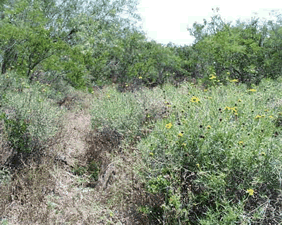South Texas Plains Wildlife Management Vegetation
The Rio Grande Plains, also known as the "brush country", encompasses about 20.5 million acres in an area extending from Del Rio to San Antonio and southeast to Rockport. Although the typical brush community, characterized by mesquite, blackbrush, brasil, and other thorny plants, dominates much of south Texas, 5 additional ecoregions influence the diversity of vegetation communities along the fringes of the area. Natural features such as soils, rainfall rates, temperatures, growing seasons, and grazing pressure shaped much of the plant communities in south Texas. Wildlife value of this region is principally derived from the diversity of plant species and vegetation communities.
Chronology of Vegetation Changes
Some of the first documentation and description of vegetation in south Texas was recorded by early Spanish explorers in the mid to late 1600s. Contrary to popular belief, the entire area was not a continuous prairie of "stirrup high" grasses. Although grasslands apparently dominated the landscape, woody plants (trees and shrubs) were often present in thickets, upland areas, major drainages and river bottoms. Mesquite was present throughout the region, but at a much lower density than today. Natural fires helped to maintain the region as a savannah, and control woody plant densities on the prairie.
As early settlers descended upon south Texas around 1820-1870 changes in the landscape and vegetation communities were inevitable. Brush appeared to intensify more rapidly near centers of populated areas than elsewhere, likely a result of livestock concentration near the towns. Larger cattle ranches were less susceptible to overgrazing at the time because cattle could move across the open range. However, the invention and introduction of barbed wire allowed the cattle barons as well as the small-acreage landowner to fence the landscape and control livestock grazing and distribution. Fencing and unrealistic expectations of grazing capacity led to overgrazing problems. The lack of grass and decreased occurrence of natural fires allowed brush to invade the open prairie/savannah country. Brush distribution was no longer restricted to river bottoms, upland areas, or in thickets on the prairie.
Brush densities and distribution across south Texas continued to increase during the late 1800s and early 1900s due to a variety of factors, which probably included overgrazing, lack of natural fires, soil compaction and periodic droughts. Ranchers regarded increased brush density as detrimental to livestock operations, and attempts to control it were intensive and widespread. The earliest attempts at brush control and range reseeding began during the late 1930s and early 1940s, with cabling and chaining. As ranchers generated income from livestock production, they also practiced rootplowing, roller chopping, Rome discing and chemical spraying to control brush and increase grass production.
Research into the effects of brush management by wildlife biologist in the late 1960s indicated that extensive brush control was detrimental to wildlife. White-tailed deer hunting also increased in popularity during the late 1950s, 1960s and 1970, giving landowners an economic incentive to provide quality habitat for white-tailed deer. Consequently, brush removal has been reduced or applied in a manner that is not detrimental to wildlife, thus improving the habitat for deer and other wildlife species. As a general rule brush removal should not exceed 25-30% of the overall area. Because of the economic importance of wildlife to many south Texas landowners, a trend towards habitat improvement and restoration is emerging today.
Habitat Health

Quality native habitats.
Quality habitats are the key to sustaining wildlife populations. By monitoring the vegetation wildlife managers can assess the overall health of the habitat or ecosystem. When assessing habitats on a property biologist tend to look at several components such as diversity of brush species, browsing pressure, amount of herbaceous cover, water distribution, stocking rates and grazing systems for livestock, deer numbers, and the use of supplemental feed. Low quality habitats generally lack good brush diversity, have sparse grass and weed cover, and shrubs may have a hedged appearance or browse line, almost as if cut with hand prunners. The most likely cause of poor habitats is too many animals on the range and not enough food. As the quality of habitat decreases, all wildlife species began to suffer. Keeping livestock and deer number at a level that can be supported by the native habitat reduces the potential to damage the vegetation. Healthy ecosystems will consist of high plant diversity, structural diversity (grasses and forbs, low growing shrubs, trees), and good ground cover.
References
Taylor, R.B., J. Rutledge, and J.G. Herrera. 1999. A Field Guide to Common South Texas Shrubs. Texas Parks and Wildlife Press, Austin, Texas, USA.
Inglis, J.M. 1964. A History of Vegetation on the Rio Grande Plain. Project W-84-R-Texas, Bulletin No. 45 Texas Parks And Wildlife Department. Austin, Texas, USA.